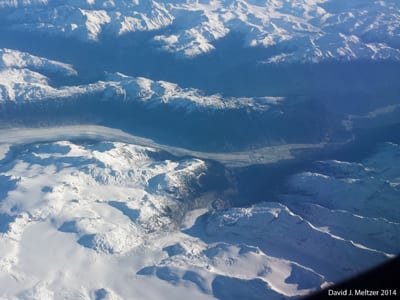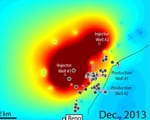No support for ‘Paleoamerican Model,’ which holds that Central and South American groups were relicts of an early and separate migration into the Americas

A new large genome-scale study reveals that the ancestors of all present-day Native Americans arrived in the Americas as part of a single migration wave, no earlier than 23,000 years ago.
The finding addresses the ongoing debate over when and how many times the ancestors of present-day Native Americans entered the New World from Siberia.
There is archaeological evidence of modern humans in the Americas by about 15,000 years ago.
The new study was conducted by an international team headed by the Centre for GeoGenetics at the University of Copenhagen.
“With this study,” said study co-author David J. Meltzer, in the Department of Anthropology, Southern Methodist University, “we are not only addressing key questions related to the peopling of the Americas, we are beginning to integrate the archaeological, anatomical and genetic evidence bearing on that process.”
The study, “Genomic evidence for the Pleistocene and recent population history of Native Americans,” published online July 21, 2015, ahead of print in the leading scientific journal Science.
Within the Americas, the ancestral Native American pool diversified into two basal branches around 13 thousand years ago. The team also reports a later gene flow into some Native Americans from groups related to present-day East Asians and Australo-Melanesians.
Finally, the results from this study show no support for certain historical Central and South American groups with distinctive cranial morphology being relicts of an early and separate migration into the Americas, as proposed by the ‘Paleoamerican Model’.
Debate centers around demographic processes that led to peopling of Americas
Although there is little disagreement in the scientific literature that the ancestors of present-day Native Americans originated in Siberia, debate over the demographic processes that led to the peopling of the Americas still persists.
Experts know through archaeological sites such as Monte Verde in Chile that humans were present in the Americas by about 15,000 years ago.
The question remains, however, as to when the first Native Americans cross over from Siberia into the New World?
Did they arrive in a single wave or did successive migration waves give rise to the genetic diversity prevalent among present-day Native Americans? Did they split from their Old World ancestors and immediately cross into the Americas? Or was there, as one genetic model suggests, an “incubation” period in Beringia, the now-inundated land bridge that connected northeastern Siberia to Alaska? And if they came in a single wave, when did the ancestral Native American population split into the genetic branches seen today among their descendants?
Tracing the initial migrations into the Americas
To develop details of when and how the Americas were peopled, the team generated genomic data from several present-day Native American and Siberian populations, which are poorly represented in the genetic literature.
The researchers also sequenced ancient samples from across the Americas, spanning about 6,000 to 200 years ago to trace the genetic structure over time.
“Our study presents the most comprehensive picture of the genetic prehistory of the Americas to date,” said one lead author Maanasa Raghavan, a postdoctoral researcher at the Centre for GeoGenetics. “We show that all Native Americans, including the major sub-groups of Amerindians and Athabascans, descend from the same migration wave into the Americas. This was distinct from later waves that gave rise to the Paleo-Eskimo and Inuit populations in the New World Arctic region.”
This initial migration of the ancestors of all present-day Native Americans happened no earlier than 23,000 years ago, the new study found.
That represents the split date of Native Americans from East Asian and Siberian populations and is very similar for both Amerindians and Athabascans, which confirms that both groups arrived into the New World as part of the same migration.
“We applied several statistical methods that differ in modelling or utilize different information in the data,” said Yun Song, a study co-author and a professor at the University of California at Berkeley. “That we obtained consistent results across different methods is significant and reassuring.”
It is likely that after diverging from Old World populations around 23,000 years ago, the ancestral Native Americans remained isolated in Beringia for about 8 thousand years ago, given that the earliest archaeological evidence for humans in the Americas is around 15 thousand years ago.
A timeline of the genomic landscape of the Americas
Since Amerindians and Athabascans were part of the same migration into the Americas, the current genetic differences observed between them would have emerged sometime after 23,000 years ago.
The team found evidence for a split in the ancestral Native American gene pool that lead to the formation of two distinct genetic branches, namely the northern and southern branches, and that this split occurred about 13,000 years ago.
The northern branch was found to be present in northern North America and included both northern Amerindian groups as well as Athabascans. The southern branch, in contrast, included Amerindians from southern North America and Central and South America.
“We can date this split so precisely in part because we previously have analyzed the 12,600 years ago remains of a boy associated with the first unique Native American culture – the Clovis culture,”said study co-author Rasmus Nielsen from the Department of Integrative Biology at the University of California at Berkeley. “The first diversification of the ancestors of modern Native Americans happened in the Americas and likely just before — or at the time of — the appearance of the Clovis culture.”
When comparing the genetic affiliations of sequenced ancient samples from the Americas, the team found that several samples were genetically more closely related to modern-day populations from the same geographical location. This result indicates that there was a genetic and geographic continuity of Native American groups across the millennia in at least some parts of the Americas.
A recent Old World connection
The study reports a signal of gene flow between some Native Americans and groups related to present-day East Asians and Australo-Melanesians, the latter including Papuans, Solomon Islanders and South East Asian hunter-gatherer groups.
While the signal is weak, it presents an intriguing scenario of a distant Old World connection to Native Americans after their split from one another and after the latter had peopled the Americas.
“It’s a surprising finding and it implies that New World population were not completely isolated from the Old World after their initial migration,” said study leader Eske Willerslev, Lundbeck Foundation Professor from the Centre for GeoGenetics at the Natural History Museum, University of Copenhagen. “We cannot say exactly how and when this gene flow happened, but one possibility is that it came through the Aleutian Islanders living off the coast of Alaska.”
A genetic relationship with the Australo-Melanesians, however weak, invokes a highly debated hypothesis in the scientific literature that suggests, based on cranial morphology, that populations related to Australo-Melanesians were part of a separate migration. From them, that gave rise to the earliest Americans (Paleoamericans), who were later replaced by the ancestors of present-day Native Americans.
Genomic analyses indicates Palaeoamericans related to preseng-day Native Americans
The current study undertook genomic analyses on historical Central and South American populations considered to be relicts of Paleoamericans, namely the Pericúes and Fuego-Patagonians. It found no evidence, however, for them being closely related to Australo-Melanesians.
On the contrary, the results show that they were genetically closest to present-day Native Americans, a finding supported by re-analysis of cranial morphological evidence.
“Our findings show that supposed Palaeoamerican relict populations, such as the Pericúes and Fuego-Patagonians, belong to the same population as present-day Native Americans and that the distinct cranial morphology of these groups is not a consequence of a distinct migration history,” said one of the lead authors, Cristina Valdiosera, a postdoctoral researcher at the Centre for GeoGenetics.
The lines of evidence do not, as yet, fully converge, said SMU’s Meltzer, an expert on the prehistoric Native American Clovis culture.
“For example, was there a causal link between the Clovis expansion known archaeologically and the genetic divergence of the northern and southern branches?” he said. “If so, how does the evidence of a pre-Clovis presence at sites such as Monte Verde fit in? As more archaeological sites and remains are dated and ancient and modern genomes are sequenced, we will be able to resolve these issues, and develop a more precise record of the colonization of what was then a truly New World.”
Willerslev said the study also seems to have challenged older hypotheses such as a Beringian incubation for Native American ancestors for tens of thousands of years; entrance to the Americas much earlier than the Last Glacial Maximum; and, independent migrations of Amerindians and Athabascan ancestors into the Americas.
“At the same time, we see surprises including genetic signals of East Asians and Australo-Melanesians, presumably coming in after the first migration wave,” he said. — University of Copenhagen, SMU
Follow SMUResearch.com on twitter at @smuresearch.
SMU is a nationally ranked private university in Dallas founded 100 years ago. Today, SMU enrolls nearly 11,000 students who benefit from the academic opportunities and international reach of seven degree-granting schools. For more information see www.smu.edu.
SMU has an uplink facility located on campus for live TV, radio, or online interviews. To speak with an SMU expert or book an SMU guest in the studio, call SMU News & Communications at 214-768-7650.


 At peak fertility, women who desire to maintain body attractiveness report they eat less
At peak fertility, women who desire to maintain body attractiveness report they eat less SMU seismology team to cooperate with state, federal scientists in study of May 7 Venus, Texas earthquake
SMU seismology team to cooperate with state, federal scientists in study of May 7 Venus, Texas earthquake 1st proton collisions at the world’s largest science experiment expected to start the first or second week of June
1st proton collisions at the world’s largest science experiment expected to start the first or second week of June Most likely cause of 2013-14 earthquakes: Combination of gas field fluid injection, removal
Most likely cause of 2013-14 earthquakes: Combination of gas field fluid injection, removal Physicists tune Large Hadron Collider to find “sweet spot” in high-energy proton smasher
Physicists tune Large Hadron Collider to find “sweet spot” in high-energy proton smasher SMU geothermal scientist Maria Richards to guide global energy organization
SMU geothermal scientist Maria Richards to guide global energy organization 17 million-year-old whale fossil provides 1st exact date for East Africa’s puzzling uplift
17 million-year-old whale fossil provides 1st exact date for East Africa’s puzzling uplift SMU analysis of recent North Texas earthquake sequence reveals geologic fault, epicenters in Irving and West Dallas
SMU analysis of recent North Texas earthquake sequence reveals geologic fault, epicenters in Irving and West Dallas Bitcoin scams steal at least $11 million in virtual deposits from unsuspecting customers
Bitcoin scams steal at least $11 million in virtual deposits from unsuspecting customers Teen girls report less sexual victimization after virtual reality assertiveness training
Teen girls report less sexual victimization after virtual reality assertiveness training Women who are told men desire women with larger bodies are happier with their weight
Women who are told men desire women with larger bodies are happier with their weight Fossil supervolcano in Italian Alps may answer deep mysteries around active supervolcanoes
Fossil supervolcano in Italian Alps may answer deep mysteries around active supervolcanoes SMU seismologist Brian Stump named AAAS Fellow for distinguished scientific contributions
SMU seismologist Brian Stump named AAAS Fellow for distinguished scientific contributions Study: Contraception may change how happy women are with their husbands
Study: Contraception may change how happy women are with their husbands Study funded by NIH is decoding blue light’s mysterious ability to alter body’s natural clock
Study funded by NIH is decoding blue light’s mysterious ability to alter body’s natural clock Jurassic climate of large swath of western U.S. was more complex than previously known
Jurassic climate of large swath of western U.S. was more complex than previously known Study will teach algebra with student-authored stories that draw on their own interests
Study will teach algebra with student-authored stories that draw on their own interests Hunt begins for elusive neutrino particle at one of the world’s largest, most powerful detectors
Hunt begins for elusive neutrino particle at one of the world’s largest, most powerful detectors Key to speed? Elite sprinters are unlike other athletes — deliver forceful punch to ground
Key to speed? Elite sprinters are unlike other athletes — deliver forceful punch to ground